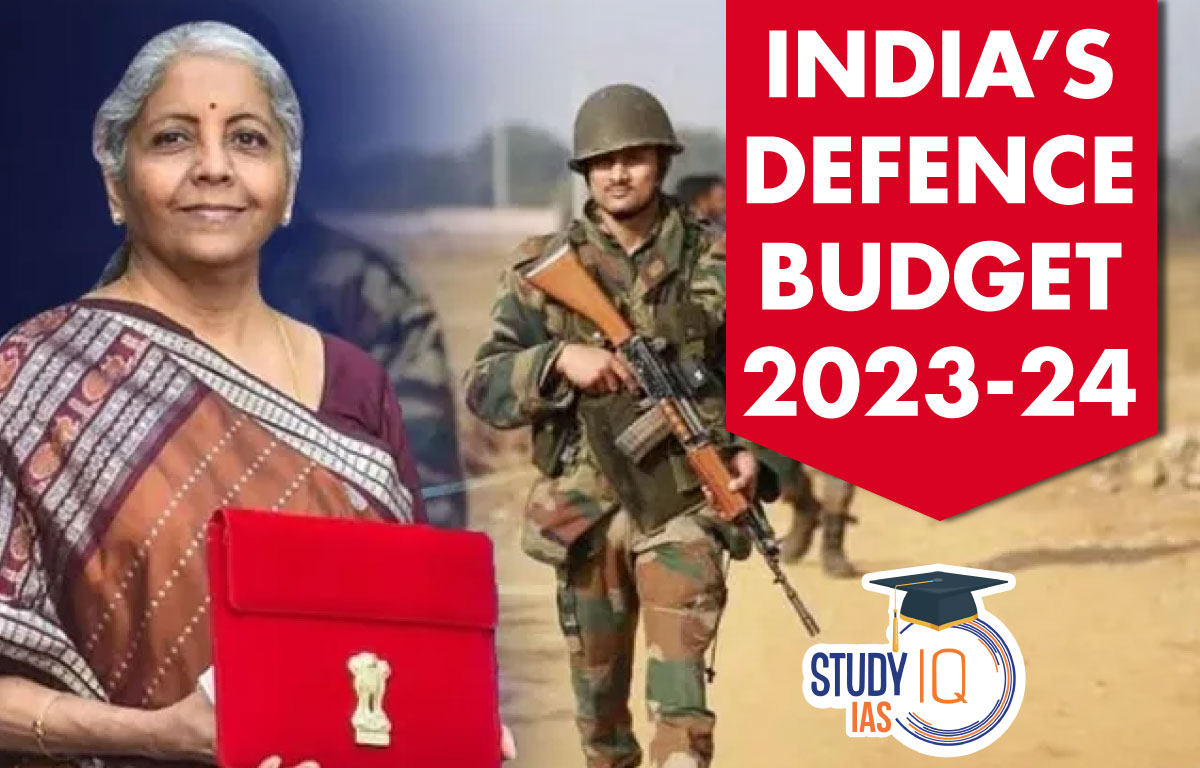Table of Contents
Context: Finance Minister announced the allocation of Rs 5,935.38 billion to the Ministry of Defence (MoD) in annual budget 2023-24.
Highlights of Defence Budget
- Overall Component of Defence Budget: 2023-24 budget represents a 13-percent increase over the previous year’s allocations.
- All the three key components of the MoD’s budget—MoD (Civil), Defence Pension, and Defence Services—have contributed to the upward revision.
- Large increases are due to hikes in the pensionary benefits and the non-salary revenue expenditure of the defence services.
- Pay and Allowances (P&A) of the armed forces has grown marginally (by 3 percent) from Rs 1,494 billion to Rs 1,545 billion.
- Reason: Depletion of the armed forces’ strength is caused by the pandemic-induced restrictions on recruitment and the unveiling of the Agnipath scheme.

- Share of Defence Services: Indian Army has the largest share in the services’ budget; however, it continues to be the least capital-intensive service.
- Share of the Navy has increased to an all-time high of 20%. It indicates India’s changing threat perceptions, from continental to maritime.
- Funding For Research and Development: Budget’s allocation for the Defence Research and Development Organisation (DRDO) is Rs 23,264 crore, a mere increase of 9 percent from the previous year’s budget.
- It has provisions to enhance the participation of startups and micro, small and medium enterprises (MSMEs) to foster innovation, encourage technology development and strengthen the defence industrial ecosystem in the country.
- Allocations for Innovation for Defence Excellence (iDEX) and Defence Testing Infrastructure Scheme (DRIS) have been enhanced by 93 percent and 95 percent to INR 1.16 billion and INR 0.45 billion respectively.
- Modernisation Budget For Armed Forces: Indian Air Force (IAF) got the largest share among the three services at INR 0.57 lakh crore, a 3.6 percent hike from FY 2022–23.
- The Indian Army was allocated INR 0.37 lakh crore—a hike of 15.6% from last year—and the Indian Navy’s capital budget was INR 0.52 lakh crore, an increase of 10.6% from the previous financial year.
- High Import Bill: MoD spent INR 1,938.79 billion on foreign procurement in the past five years alone.
- Border Tension: Upward revision of the non-salary revenue expenditure is mostly driven by the exigencies created by the ongoing crisis at the border.
- It has led to a significant increase in the capital expenditure of the Border Roads Organisation (BRO).
- BRO enhanced allocations will boost the border infrastructure thereby creating strategically important assets to improve border connectivity.
- Counter China’s aggressive activities: Ongoing border standoff with China is a stark reminder of the grave security and strategic challenges that India faces from its northern neighbour.
- China spends massive amounts on its military and India is not in a position to match Beijing’s defence spending.
- Increase in the ‘Stores’ expenditure Budget: It caters to the repair and maintenance of existing equipment, as well as for procurement of critical ammunition/spares and niche capabilities to address immediate shortages.
Conclusion
- India must deepen its security and strategic partnerships with like-minded countries opposed to Chinese belligerence.
- India’s embrace of the Quad, its tacit support to AUKUS, and its renewed focus on building defence and security partnerships with countries in the Indo-Pacific and beyond, indicate India’s strategy and preference for seeking a coalition of partners to deter Chinese hegemony.
- India needs to increase its defence spending on a sustained manner and ensure that greater proportions are devoted to the modernisation of the defence forces.
- However, a budget that is high on revenue and low on capital does not augur well for India’s defence posture.
- Agnipath Scheme: It entails a recruitment process for individuals below the rank of officer, with the goal of deploying fitter, younger troops on the front lines, many of whom will be on four-year contracts.
- Innovations for Defence Excellence (iDEX) framework: It was launched by the Government with the aim to foster innovation and technology development in Defence and Aerospace Sector by engaging Industries including MSMEs, start-ups, individual innovators, R&D institutes and academia and to promote self-reliance.
- Defence Testing Infrastructure Scheme (DTIS): To boost domestic defence and aerospace manufacturing,
- It envisages setting up of 6-8 Greenfield Defence Testing Infrastructure facilities that are required for defence and aerospace related production.
- Technology Development Fund (TDF): It has been established to promote self-reliance in defence technology as a part of the ‘Make in India’ initiative.
- It is a programme of MoD (Ministry of Defence) executed by DRDO meeting the requirements of Tri-Services, Defence Production and DRDO.


 Daily Quiz 17 April 2025
Daily Quiz 17 April 2025
 Nilgiri Biosphere Reserve, Map, Climate,...
Nilgiri Biosphere Reserve, Map, Climate,...
 Complete List of Indian State Animals
Complete List of Indian State Animals





















